As poverty worsens, Duterte admin parades increments of good news
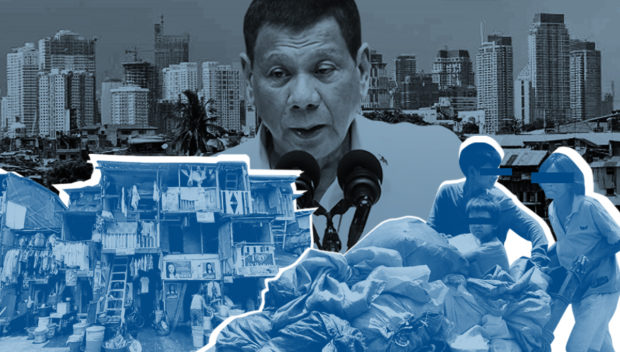
MANILA, Philippines—The government is officially blind on poverty.
That’s because, according to Social Weather Stations (SWS) president Mahar Mangahas, the government’s latest Family Income and Expenditure Survey (FIES) was in 2018 yet. New data from FIES, which could be a gauge of poverty nationwide, won’t be available until 2022, should FIES be done during the pandemic, Mangahas said in his Inquirer column last July 17.
But results of the SWS’ poverty report for May 2021 showed an alarming set of data:
- Half, or 50 percent, of all families in the country said they felt poor
- One-third said they were borderline poor
- Only one-sixth said they were not poor
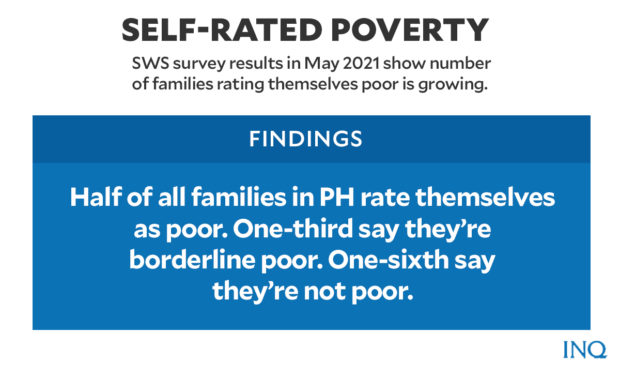
Graphic by Ed Lustan
According to Mangahas in his column, the numbers were “essentially unchanged” from the SWS’ previous report in November 2020, when face-to-face field work, required for poverty self-rating, resumed.
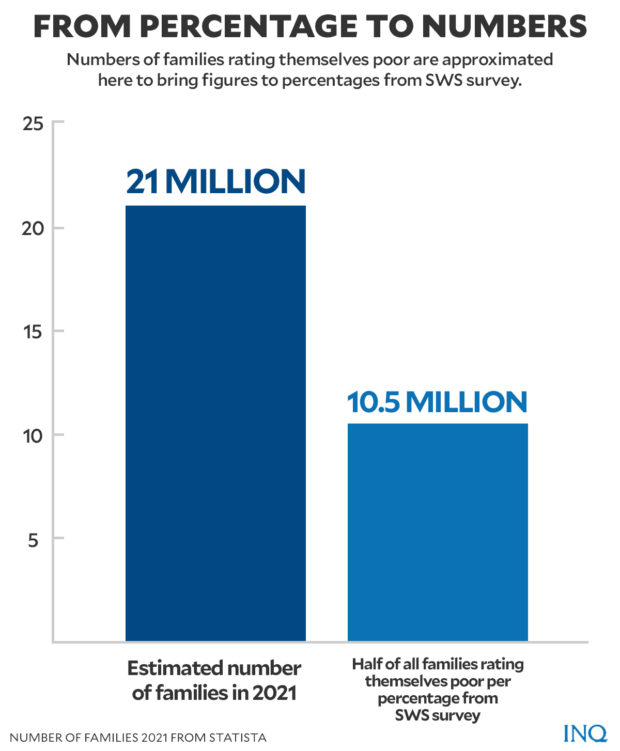
Graphic by Ed Lustan
The data website Statista said the number of families in the Philippines in 2021 was projected to rise to 21 million. Half of that would be 10.5 million. Juxtaposed with survey results from SWS, that would be the approximate number of families rating themselves poor in the SWS’ May 2021 poverty report.
Article continues after this advertisementAccording to the Philippines National Demographic and Health Survey of 2008, there are nearly five people (4.8) per family in the Philippines. If half of all the families in the country rated themselves as poor, that would be more than 50 million people, which is 34 million more than the number of votes that Rodrigo Duterte got to win the presidential elections in 2016.
Article continues after this advertisement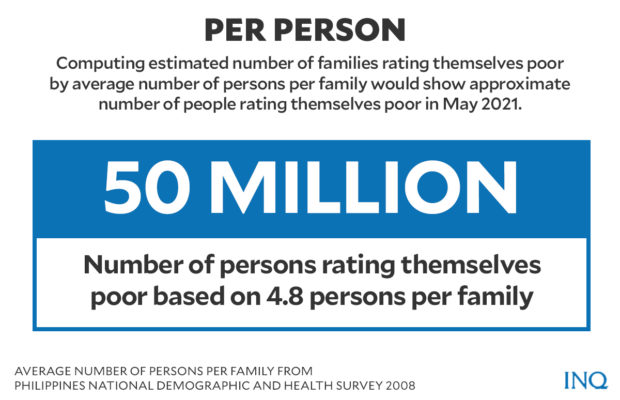
Graphic by Ed Lustan
The May 2021 SWS survey results, according to Mangahas in his column, showed a worsening of self-rated poverty. Before the pandemic in 2019, results of four quarterly surveys by SWS showed an average 45 percent of all families saying they were poor. Some 31 percent said they were borderline poor and 24 percent said they were not poor.
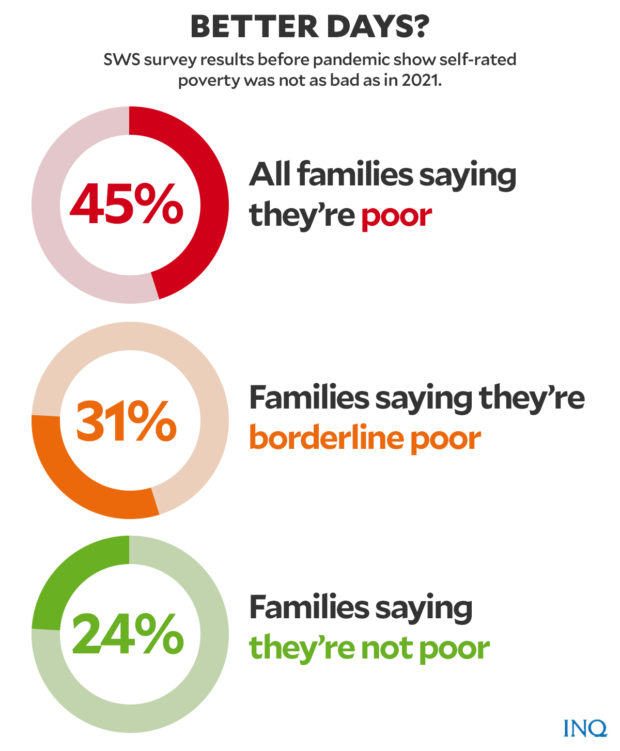
Graphic by Ed Lustan
In May 2021, the SWS survey results showed, at least 39 percent of all families in National Capital Region (NCR) said they were poor. The rates were higher outside the capital. It was 45 percent of all families in the rest of Luzon, 56 percent in the Visayas and 59 percent in Mindanao, Duterte’s home region. Families saying they were not poor was 30 percent in NCR, 24 percent in the rest of Luzon outside NCR, 5 percent in the Visayas and 6 percent in Mindanao.
Still according to Mangahas in his Inquirer column, median self-rated poverty threshold per month, or the amount that families feel they need to not feel poor every month, is P20,000 in NCR. It’s P15,000 in the rest of Luzon, P10,000 in the Visayas and P12,000 in Mindanao.
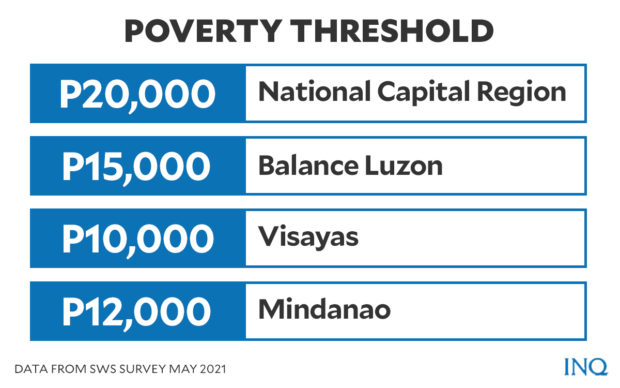
Graphic by Ed Lustan
“The thresholds are reasonable, the poor have modest aspirations,” wrote Mangahas.
Citing results of SWS survey, he said median poverty gap, or the amount that would keep families on or above the poverty line, was P8,000 in NCR. It’s P6,000 in the rest of Luzon, P5,000 in the Visayas and P5,000 in Mindanao.
“It is the midpoint of what the poor say is the distance from their own poverty threshold,” wrote Mangahas. “The gaps are significant, the poor are not petty.”
As the nation awaits Duterte’s last State of the Nation Address (SONA) on Monday (July 26), it would be interesting to ask people if they felt their lives improved in Duterte’s reign but for now, numbers could suffice to show how the people fared in terms of jobs and livelihood.
More workers, job seekers
There’s always a race involving only two runners — growth in labor force and growth in jobs. In most cases, the first always wins.
The population of workers, 15-years and older, entering the labor force every year continues to increase and did so again under Duterte.
In July 2016, a month into Duterte’s term, the labor force — the total number of Filipinos with the ability to work — was 63,443,000. A year later, it was 70,164,000.
The numbers further went up to 71,561,000 in July 2018, 72,446,000 in 2019 and 74,061,000 in 2020.
Data from the Philippine Statistics Authority (PSA) showed a labor force participation rate — those actually working or actively searching for jobs — was 63.20 percent in 2016, 60.60 percent in 2017, 60.10 percent in 2018, 62.10 percent in 2019 and 61.90 percent in 2020.
More jobs?
The employment numbers are a gauge of how far Duterte has gone in improving people’s lives. In his first SONA, he promised to alleviate poverty.
“My administration will continue and maintain current macroeconomic policies and even do better,” Duterte said then.
“Prudent and monetary policies,” he said, “can help translate high growth into more and better job creation and poverty reduction.”
Duterte had frowned upon the underspending that marked the rule of his predecessor, the late Benigno Aquino III. For Duterte, it should be spend, spend, spend especially on his P8.4-trillion “Build, Build, Build” centerpiece infrastructure program.
Launched in 2017, Build, Build, Build would usher in, according to Duterte and his officials, a “golden age of infrastructure.”
READ: Palace vows to create more jobs through more foreign investments
READ: Dutertenomics: ‘Golden age of infrastructure’
The P8.4 trillion flagship infrastructure project seeks to accelerate infrastructure spending and develop industries that will yield robust growth, create jobs and improve the lives of Filipinos.
According to the Department of Budget and Management (DBM), the Build, Build, Build program is expected to generate at least 1.1 million jobs annually that are mostly associated with but are not limited to construction and development.
Based on numbers from then-Socioeconomic Planning Secretary and National Economic and Development Authority (NEDA) chief Ernesto M. Pernia, the program created at least “600,000 plus jobs” in April 2018 — a big chunk in construction.
READ: 10-year high: Employment rate inches up to 94.6% in July
The Department of Finance (DOF) likewise reported in 2018 that the construction sector grew by 12.7 percent in 2016.
From 3.5 million workers in April 2017, the number of workers in construction shot up to 4.2 million in April 2018.
The overall annual employment rate declined from 94.50 percent, or 40.8 million employed individuals in 2016, to 94.30 percent or 40.3 million in 2017.
It improved, however, in 2018 which saw employment rate of 94.70 percent, or 41.2 million people, and 94.90 percent, or 42.4 million, in 2019.
Unemployment, underemployment
While the employment figures were promising, unemployment rate in the first three years of Duterte’s reign was 5.10 to 5.70 percent showing small increments of improvement that can hardly change the picture.
As defined by the government, unemployed people are those:
- Without work
- Currently available for work
- Seeking work or not seeking work because of the belief that no work is available
- Awaiting results of job applications
- Waiting for rehire or job recall after illness or disability
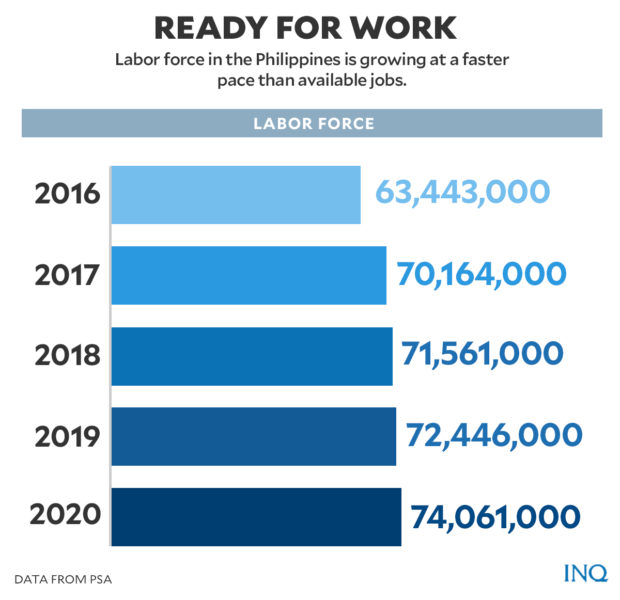
Graphic by Ed Lustan
Initial results of PSA’s Annual Labor and Employment Estimates for 2016 based on the average of four Labor Force Survey (LFS) rounds—January, April, July and October—reported an annual unemployment rate of 5.5 percent or at least 2,363,000 Filipinos. In 2017, it climbed to 5.70 percent or an estimated 2,441,000 unemployed Filipinos.
The numbers subsided in 2018 and 2019 with an unemployment rate of 5.30 percent or 2,303,000 Filipinos and 5.10 percent or 2,264,000 Filipinos respectively.
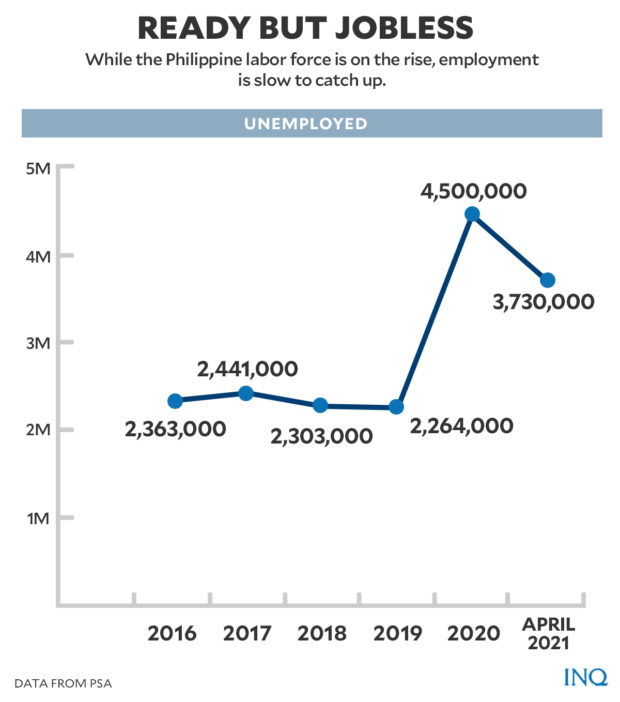
Graphic by Ed Lustan
On the other hand, those who are considered underemployed or people with jobs but with short hours declined.
In 2016, at least 7,513,000 were classified as underemployed. The numbers went down in 2017 to 6,506,000. It went back up in 2018 with 6,734,000 but dropped in 2019 after PSA recorded 5,934,000 underemployed persons.
Pandemic strikes
When the COVID-19 pandemic landed on Philippine shores in 2020, a surge in COVID cases was also marked by a surge in unemployment.
Lockdowns that kept millions at home led to business closures and pushing unemployment to a high of 17.7 percent in April 2020.
National Statistician Claire Dennis Mapa, citing preliminary results of PSA’s LFS, said that 7.3 million Filipinos were unemployed that month—the highest since April 2005.
READ: Amid ECQ, ‘record-high’ unemployment rate of 17.7% posted in April
Overall, at least 4.5 million Filipinos were left jobless for the whole year of 2020, or an equivalent of 10.3 percent, the highest in 15 years.
The PSA report said the number of Filipinos with jobs in 2020 fell to 39.4 million from 42.4 million in 2019. Underemployment worsened to 16.2 percent from 13.8 percent in 2019.
READ: Batch 2020: How Filipino college graduates job-hunted through the pandemic
This March, the PSA reported slight improvements. LFS result showed unemployment rate fell to 7.1 percent, or 3.44 million people who are jobless.
But the Department of Labor and Employment (DOLE) took pride in the numbers. The unemployment rate of 7.1 percent, DOLE said in a statement, was “already the lowest” since the pandemic began.
“The signs are indeed encouraging,” DOLE added. “Our economy is gradually getting back on track as more people are actively participating in the labor force and are becoming employed.”
The PSA also noted that 2.18 million workers were added to the total number of employed individuals, leading to 45.33 million or 92.9 percent employment rate in March.
The PSA said there was a “slight” decline in underemployment from 7.85 million in February 2021 to 7.34 million in March 2021, with 510,000 employees lifted out of the category.
READ: Unemployment at lowest during pandemic – survey
Labor Secretary Silvestre Bello III said last June that a total of 2,068 establishments had closed down during the pandemic.
READ: 69,022 jobless after virus shut down 2,068 companies – DOLE
Latest PSA data showed that the country’s unemployment rate last May was 7.7 percent.
The total number of unemployed individuals reached 3.73 million. Labor participation rate went up to 64.6 percent from 63.1 percent last April.
Employment rate, said the PSA in a report, “rebounded.”
Recovery
To recover from the pandemic-induced recession, Duterte signed the Corporate Recovery and Tax Incentives for Enterprises Act (CREATE) bill into law.
CREATE will cut corporate taxes across the board and rationalize tax breaks. From Southeast Asia’s highest corporate tax of 30 percent, the rate will drop to 25 percent for large corporations and to 20 percent for smaller businesses.
The Department of Trade and Industry (DTI) estimated that P200 billion new investments would come in and at least two million new jobs will be created as a result.
READ: Duterte signs CREATE bill into law
Duterte has also adopted the National Employment Recovery Strategy (NERS) aimed at promoting and implementing job-generating programs amid the COVID-19 pandemic.
In addition, the government’s Build, Build, Build program is set to generate 1.6 million more jobs in 2021, according to Public Works Secretary Mark Villar.
READ: Infra projects to create 1.6M more new jobs this year–Villar
Several Filipinos feel poor
In 2018, survey results from SWS showed that around 11.6 million Filipino families, or 50 percent consider themselves poor.
The survey also bared that at least 30 percent or 7.9 million Filipino families were “food poor.”
READ: SWS: 11.6M Filipino families say they are poor
The percentage of families who rated themselves as poor further increased in 2019 with 54 percent or 13.1 million families—the highest under the Duterte regime.
READ: SWS: More Filipinos consider selves poor, self-rated poverty highest in 5 years
However, from November 21 to 25, 2020, only 48 percent of Filipino families rated themselves poor.